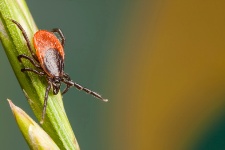 It turns out that ticks carrying the bacteria that trigger Lyme disease are not the only ones you have to worry about anymore: researchers have traced a new virus-carrying lone star tick that infected two men in Missouri. The findings, published in the American Journal of Tropical Medicine and Hygiene this week, found that two men were infected with the HRTV virus in 2009 in Missouri, and required hospitalization, although they both eventually recovered. Although researchers didn’t know what they were infected with at the time, they’ve now identified that lone star ticks were carrying this novel virus. The two men were bitten in early 2009, and came to the hospital with fever, headaches, and low white blood cell and platelet counts. Doctors expected their lab results to show a diagnosis of ehrlichiosis, a disease carried by ticks that live in this area—but instead they discovered a new, unheard of virus. Eventually, they diagnosed the men with the “Heartland” virus (HRTV), a virus that is carried by sandflies, mosquitoes, and ticks.
It turns out that ticks carrying the bacteria that trigger Lyme disease are not the only ones you have to worry about anymore: researchers have traced a new virus-carrying lone star tick that infected two men in Missouri. The findings, published in the American Journal of Tropical Medicine and Hygiene this week, found that two men were infected with the HRTV virus in 2009 in Missouri, and required hospitalization, although they both eventually recovered. Although researchers didn’t know what they were infected with at the time, they’ve now identified that lone star ticks were carrying this novel virus. The two men were bitten in early 2009, and came to the hospital with fever, headaches, and low white blood cell and platelet counts. Doctors expected their lab results to show a diagnosis of ehrlichiosis, a disease carried by ticks that live in this area—but instead they discovered a new, unheard of virus. Eventually, they diagnosed the men with the “Heartland” virus (HRTV), a virus that is carried by sandflies, mosquitoes, and ticks.
Researchers don’t know if the virus is likely to spread; however, researchers have collected varieties of samples of ticks and found other ticks that did carry the HRTV virus. To help prevent the spread of this disease, the U.S. Centers for Disease Control and Prevention and the Missouri Department of Health and Senior Services is working to identify all sources of the virus and contain them.
The biggest problem is that to date, there’s no treatment available for the HRTV virus and, unlike other tick-borne diseases such as Lyme disease and ehrlichiosis, HRTV is a real virus which doesn’t respond to current antibiotics.
MORE: Lyme Disease, the Hidden Epidemic
If you’re wondering how to spot these disease-carrying bacteria, lone star ticks have, as their name suggests, one lone white spot on females. They’re common in certain areas of the U.S., especially northwestern Missouri.
“This research illustrates the ever-changing world we live in and why we must sustain our nation’s investment in research into these types of diseases that the majority of Americans will never hear of,” said David H. Walker, MD, president of the American Society of Tropical Medicine and Hygiene, who researches tick-borne diseases. “It is only by getting trained experts into the field and doing the necessary work of collecting and testing thousands of specimens, as these scientists did, that we can be one step ahead of what could become another serious health threat carried by ticks.”
There are a few preventative measures you can take to prevent catching the HRTV virus or other tick-borne diseases:
- Always wear bug repellant when you’re spending time outdoors
- If you’ve spent a significant amount of time in the outdoors, double check your body for ticks when you come indoors
- Always shower as soon as you get back from a nature trip or hike
- If you notice any symptoms, such as a fever, rash, or illness after time spent outdoors, visit your doctor and let him/her know you have been in the outdoors.
Source(s) for Today’s Article:
“Scientists prove ticks harbor heartland virus, a recently discovered disease in the United States,” ScienceDaily web site, July 22, 2013; http://goo.gl/rT2V46, last accessed July 24, 2013.
